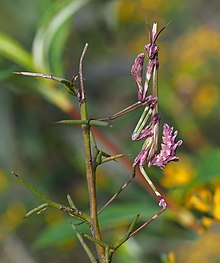
The European mantis is a large hemimetabolic insect in the family of the Mantidae ('mantids'), which is the largest family of the order Mantodea (mantises). Their common name praying mantis is derived from the distinctive posture of the first pair of legs that can be observed in animals in repose. It resembles a praying attitude. Both males and females have elongated bodies with two pairs of wings. The most striking features that all Mantodea share are a very mobile, triangular head with large compound eyes and their first pair of legs, which is highly modified for the efficient capture and restraint of fast-moving or flying prey.

Forficula auricularia is a species complex comprising the common earwig. It is also known as the European earwig. It is an omnivorous insect belonging to the family Forficulidae. The name earwig comes from the appearance of the hindwings, which are unique in their resemblance to human ears when unfolded. The species name of the common earwig, auricularia, is a specific reference to this feature. The European earwig survives in a variety of environments. It is also a common household insect in North America. They are often considered a household pest because of their tendency to invade crevices in homes and consume pantry foods, though they may also act as beneficial species depending on the circumstances.

Misumena vatia is a species of crab spider with a holarctic distribution. In North America, it is called the goldenrod crab spider or flower (crab) spider, as it is commonly found hunting in goldenrod sprays and milkweed plants. They are called crab spiders because of their unique ability to walk sideways as well as forwards and backwards. Both males and females of this species progress through several molts before reaching their adult sizes, though females must molt more to reach their larger size. Females can grow up to 10 mm (0.39 in) while males are quite small, reaching 5 mm (0.20 in) at most. Misumena vatia are usually yellow or white or a pattern of these two colors. They may also present with pale green or pink instead of yellow, again, in a pattern with white. They have the ability to change between these colors based on their surroundings through the molting process. They have a complex visual system, with eight eyes, that they rely on for prey capture and for their color-changing abilities. Sometimes, if Misumena vatia consumes colored prey, the spider itself will take on that color.
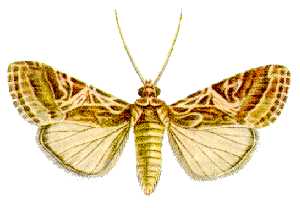
Spodoptera litura, otherwise known as the tobacco cutworm or cotton leafworm, is a nocturnal moth in the family Noctuidae. S. litura is a serious polyphagous pest in Asia, Oceania, and the Indian subcontinent that was first described by Johan Christian Fabricius in 1775. Its common names reference two of the most frequent host plants of the moth. In total, 87 species of host plants that are infested by S. litura are of economic importance. The species parasitize the plants through the larvae vigorous eating patterns, oftentimes leaving the leaves completely destroyed. The moth's effects are quite disastrous, destroying economically important agricultural crops and decreasing yield in some plants completely. Their potential impact on the many different cultivated crops, and subsequently the local agricultural economy, has led to serious efforts to control the pests.

Agrotis ipsilon, the dark sword-grass, black cutworm, greasy cutworm, floodplain cutworm or ipsilon dart, is a small noctuid moth found worldwide. The moth gets its scientific name from black markings on its forewings shaped like the letter "Y" or the Greek letter upsilon. The larvae are known as "cutworms" because they cut plants and other crops. The larvae are serious agricultural pests and feed on nearly all varieties of vegetables and many important grains.
Prey detection is the process by which predators are able to detect and locate their prey via sensory signals. This article treats predation in its broadest sense, i.e. where one organism eats another.

Matutinal, matinal, and matutine are terms used in the life sciences to indicate something of, relating to, or occurring in the early morning. The term may describe the morning activities of crepuscular animals that are significantly active during the predawn or early hours and which are then active again in the evening’s twilight. During the morning twilight period and shortly thereafter, these animals partake in important tasks, such as scanning for mates, mating, and foraging.
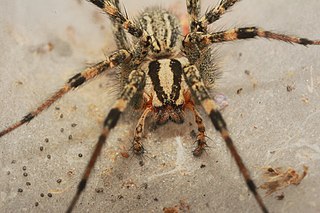
Agelenopsis aperta, also known as the desert grass spider or funnel-web spider, is a species of spider belonging to the family Agelenidae and the genus Agelenopsis. It is found in dry and arid regions across the southern United States and into northwestern Mexico. Their body is about 13–18 mm long and they have relatively long legs in order to run after their prey. Desert grass spiders can withstand very low temperatures even though they do not cold harden. It constructs the characteristic funnel-shaped webs in crevices where the funnel will fit, where they wait in the tube for prey which they can run after using their long legs. They often hunt for their prey at night.
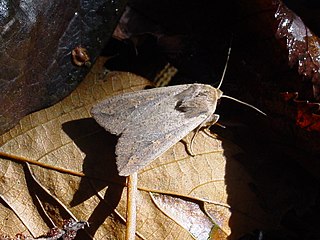
Mythimna unipuncta, the true armyworm moth, white-speck moth, common armyworm, or rice armyworm, is a species of moth in the family Noctuidae. The species was first described by Adrian Hardy Haworth in 1809. Mythimna unipuncta occurs in most of North America south of the Arctic, as well as parts of South America, Europe, Africa, and Asia. Although thought to be Neotropical in origin, it has been introduced elsewhere, and is often regarded as an agricultural pest. They are known as armyworms because the caterpillars move in lines as a massive group, like an army, from field to field, damaging crops.

Litaneutria minor, or the agile ground mantis or minor ground mantid, is native to the drier regions of North America. L. minor is found in the United States in Colorado, Arizona to Mexico, and the eastern regions of Washington to California. They also can be found in Canada in the southern Okanagan Valley and are Canada's only native mantis. They are very active hunters and will be seen running across the ground from early spring to late summer.
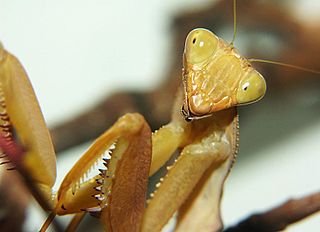
Sphodromantis lineola, common name African mantis or African praying mantis, is a species of praying mantis from Africa sometimes raised in captivity. S. lineola is often colored green, however they can also be colored different types of brown. The brown colored individuals have also been observed with purple colored eyes. It may be distinguished from S. baccettii by the absence of blue-black spots on its forearms.

Empusa fasciata is a species of praying mantis in the genus Empusa in the order Mantodea.

The dubious dtella, native Australian house gecko, or dubious four-clawed gecko is a species of gecko in the genus Gehyra, native to Northeastern Australia. The lizard is found in a variety of habitats, including acacia and eucalyptus woodlands, and in human-developed habitats, such as house walls in urban areas. Its urban presence makes it known as a common house gecko in Queensland. These geckos are often confused with the Asian common house gecko, which was introduced to Australia from Indonesia, but G. dubia has distinct rounded feet and quieter calls.

Mantises are an order (Mantodea) of insects that contains over 2,400 species in about 460 genera in 33 families. The largest family is the Mantidae ("mantids"). Mantises are distributed worldwide in temperate and tropical habitats. They have triangular heads with bulging eyes supported on flexible necks. Their elongated bodies may or may not have wings, but all Mantodea have forelegs that are greatly enlarged and adapted for catching and gripping prey; their upright posture, while remaining stationary with forearms folded, has led to the common name praying mantis.

Sexual selection in insects is about how sexual selection functions in insects. The males of some species have evolved exaggerated adornments and mechanisms for self-defense. These traits play a role in increasing male reproductive expectations by triggering male-male competition or influencing the female mate choice, and can be thought of as functioning on three different levels: individuals, colonies, and populations within an area.
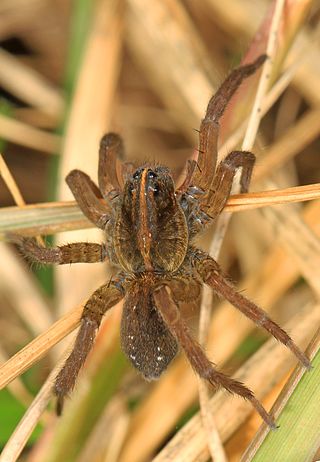
Tigrosa helluo, commonly known as the Wetland Giant Wolf Spider, is a species of spider belonging to the family Lycosidae, also known as wolf spiders. T. helluo was formerly known as Hogna helluo before differences between dorsal color patterns, habitat preferences, body structures, etc. were discovered. The species is native to the United States, Canada, and Mexico. It can be found across the eastern half of the United States, primarily in the Northeast and New England, and as far west as Nebraska and Kansas. T. helluo can be found in diverse habitats including woods, marshes, fields, and riparian areas. Typically, members of this species prefer to live in wetter areas as opposed to dry environments. Males tend to live for around a year and females will live for close to two years.
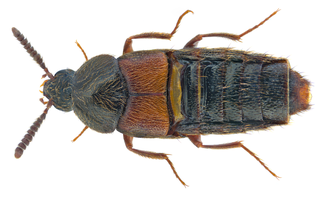
Aleochara curtula is a species of rove beetle in the family Staphylinidae. They are commonly known as Shortened Minute Rove Beetle. This beetle is found in Europe, Northern Asia and North America.

Mastophora hutchinsoni, also known as the American bolas spider, is a species of orb weaver in the genus Mastophora. The genus is distributed extensively throughout various subtropical geographical areas including Australia, South Africa, Oriental Asia, and the Americas and is not found in Europe. The hunting behavior of adult female M. hutchinsoni is unusual because they are bolas spiders. They mimic moth pheromones to attract male moths, and female M. hutchinsoni have evolved to alter their chemical release to target different moths. They then capture their prey with a sticky drop on the end of a silk line, resembling a bolas.
Schizocosa stridulans is a sibling species of S. ocreata and S. rovneri and is part of the wolf spider family. The name of the genus comes from the epigynum structure being lycosid and having a split T excavation. This spider is well-known for its specific leg ornamentation and courtship rituals and that is how it has been differentiated from its related species. The S. stridulans take systematic steps during its courtship ritual, which involves two independent signals. More specifically, female spiders will leave silk and pheromones to communicate that they are ready to mate.
Latrodectus revivensis, also known as the desert widow, is a species of venomous spider belonging to the Latrodectus genus and located in the Negev desert and the Arava valley (Arabah).
